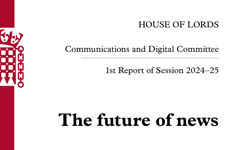During the last couple of years there has been a lot of talk about ebooks (electronic magazines) and how they will soon replace the printed copy in the magazine industry. Although I think that this view is an exaggeration (just as I never quite believed that the internet would kill retail) I whole-heartedly believe that ebooks will continue to flourish, particularly in business-to-business (B2B), and become a vital part of all magazine publishing strategies in future.
Over the next few hundred words I will talk about some of the different business models available for ebook publishing and also highlight the current issues regarding the auditing of them. Finally I’m going to take a brief glimpse at what future technology may hold for the electronic magazine.
What is an ebook?
Firstly let’s clarify what an ebook is. It’s an electronic copy of a magazine. It has pages, articles, features, advertising, pictures and a cover, just as with a print edition. In short, it is a replica of a printed magazine, just electronic. It’s definitely not a web site or for that matter an email newsletter.
Not all ebooks are the same
There are a number of competing technologies available that enable you to publish and distribute your ebooks. They range from a basic PDF, using Adobe’s Acrobat, which requires you to send a separate email notification to inform the reader the ebook is ready to download; to more advanced and function-rich software such as Zinio, which features its own download manager and bespoke distribution system. There are plenty more out there and they each treat ebooks slightly differently, operate different cost structures and have different features, so you will need to explore which one suits your magazines, readers and business before committing. Personally, I think Zinio is by far the best product on the market today.
So, where’s the money?
It’s all well and good being one of the first to market with a new idea as you get the enviable reputation of being known as innovative and pioneering, but at the end of the day we’re all in business to make money and have an FD to ensure that we do. So, no matter how innovative the idea is, it still needs to demonstrate a return at some point. Working as head of circulation & databases at VNU I have had the opportunity to experience both. Yes, we were one of the first to develop ebooks in Europe and yes, we needed to develop business models to ensure they were financially viable. To follow are just a few of the different models you could adopt as part of your ebook publishing strategy.
Controlled circulation
* Replacement model: the most obvious and attractive approach for B2B publishers is "replacement". With this strategy you simply replace x thousand of your printed circulation with ebooks and then, depending on the type of magazine and ebook technology you are using, save between 50% and 90% on current costs. You can do this in two ways: self-selection, where you let the reader choose, or pre-selection, where you decide which readers should get the ebook. Both have their benefits and risks, so test carefully. As your total circulation is the same, you can maintain advertising rate-card and therefore yields, leading to improved profitability for your magazine due to a reduction in costs. It is worthwhile ensuring your sales teams are ready to handle any potential concerns or questions that may be raised by clients regarding this new combined circulation.
* Growth model: similar to the replacement model is the "growth" approach, but instead of replacing existing print circulation, you attract new readers on ebook only and increase your overall circulation. Although ebooks can be substantially cheaper than a printed magazine to produce and distribute, there are still a number of associated costs, so once you’ve completed this exercise you should look to increase your advertising yields in line with the new bigger circulation you are now able to offer your clients. A word of warning here; as with all changes to your circulation strategy you should proceed with caution when adding ebooks to your circulation and I recommend you talk to key clients about what you’re planning before you do it.
* Launch model: due to the cost dynamics of ebooks, developing and launching a special or one-shot is relatively cheap. You could, for example, focus in a specific area that your magazine already covers and launch an ebook that just covers that topic. Simply select the target audience using demographics from your existing circulation database and then choose the best advertising approach. You could maintain a display advertising approach as your main magazine is likely to have, or alternatively you could try sponsorship of the entire ebook with just one client. We’ve done that a number of times and had a great response! It really depends on your magazine and the market you operate in as to which one will work best for you.
Paid-for circulation
As most business magazines (controlled circulation) are received at work, for a consumer magazine to succeed you need to have the right type audience or the right content to attract such an audience. I’ll explain. With your ebook edition only available via subscription and sent electronically, you are immediately limiting your title’s potential reach. There’s no newsstand presence and only customers with Internet access and who have a PC are potential readers for your ebook edition or launch. That means you need to have readers that are likely to have PCs both at home and probably work and use them frequently.
If you have, then there are some great savings to be made and you should be testing an ebook edition right now. Operating with no paper, print, production and distribution costs your product costs are minimal and you can afford to offer ebook subscriptions at a rate less than your print subscriptions and achieve a better return than print. Why do you think that Ziff Davis in the US has an ebook edition of PC Magazine that has over 170,000 subscribers!
A couple of years ago at VNU we re-launched the European version of PC Magazine, a print product we’d previously closed, as an ebook only title and have had some fairly good results with the number of paying subscribers continuing to grow steadily. More recently we’ve launched ebook editions (on Zinio) of Computeractive and Personal Computer World to sit alongside existing print products. Early indications are good, particularly for our overseas readers who love the immediacy of delivery.
Potential auditing headaches
There is currently a lot of confusion in the industry regarding the auditing of ebooks that is no doubt putting some publishers off (or at least delaying them) pursuing an ebook strategy and as such slowing down development within the industry. The two leading audit bodies in the UK, the ABC and BPA Worldwide, both audit ebooks but treat them in a very different way. I’ll try to briefly summarise their positions.
The ABC will audit your ebooks as part of your normal print audit, although on your audit certificate any ebook circulation will not be included in the overall headline circulation figure; ie. the print and ebook circulations are not combined. This means that you cannot easily demonstrate to clients and agencies the total circulation of your magazine (the two figure are separate) even though they are one and the same, making it all the harder to monetise the ebook part of your circulation.
BPA Worldwide, on the other hand, will audit and combine your ebook circulation with your print circulation on its certificates, so it is included in the headline figure and, as such, enables you quickly and simply to demonstrate total circulation to your clients and monetise it accordingly. The problem is that BPA Worldwide is still unknown in the UK and, where it does operate, it is predominantly within the B2B arena.
So with the ABC, being the biggest UK auditor of magazines by a mile, not allowing print and ebooks to be combined on its audits, it potentially restricts the majority of publishers who want to develop an ebook strategy, as they cannot monetise their new circulation as effectively.
This is a big problem for us all, but I believe that it is only a matter of time before the ABC has to change its rules and align itself with the changing media landscape that publishers now operate in. After all, the ABC is here for the industry, to help the industry.
New technology needed
Ignoring all of the issues we face as publishers (and there are a few) there is still the need to persuade readers, particularly of consumer titles, to use ebooks more. That first means we must improve the mobility and flexibility of ebooks mainly by developing new devices to view them on.
There are a number of new technologies that are already being developed that will help do this. My current favourite is a flexible display from Polymer Vision (a Philips owned company - see http://www.polymervision.nl/ for details). This fascinating technology will allow manufacturers to develop displays that can actually be rolled up (just like a print magazine) and carried in a pocket, briefcase or handbag. This type of innovation is just what is needed to allow ebooks to increase their penetration into new audiences.
And the future
B2B publishers will continue to focus their attentions on ebooks, driven predominantly by the cost-saving potential, but also because of the opportunity to grow their circulations (audiences) cost effectively. And this will ensure ebooks don’t go away. But it is only when the ABC changes its outdated rules and treats ebooks as equal to print, and when technology provides us with a truly flexible viewing solution that they will really take off. Roll-on the future and long live ebooks!
FEATURE
How ebooks can make money!
Everyone’s talking about ebooks. Most believe they’re here to stay but many in publishing are still uncertain about the precise business model. VNU’s Mark Judd outlines some of the commercial opportunities.










